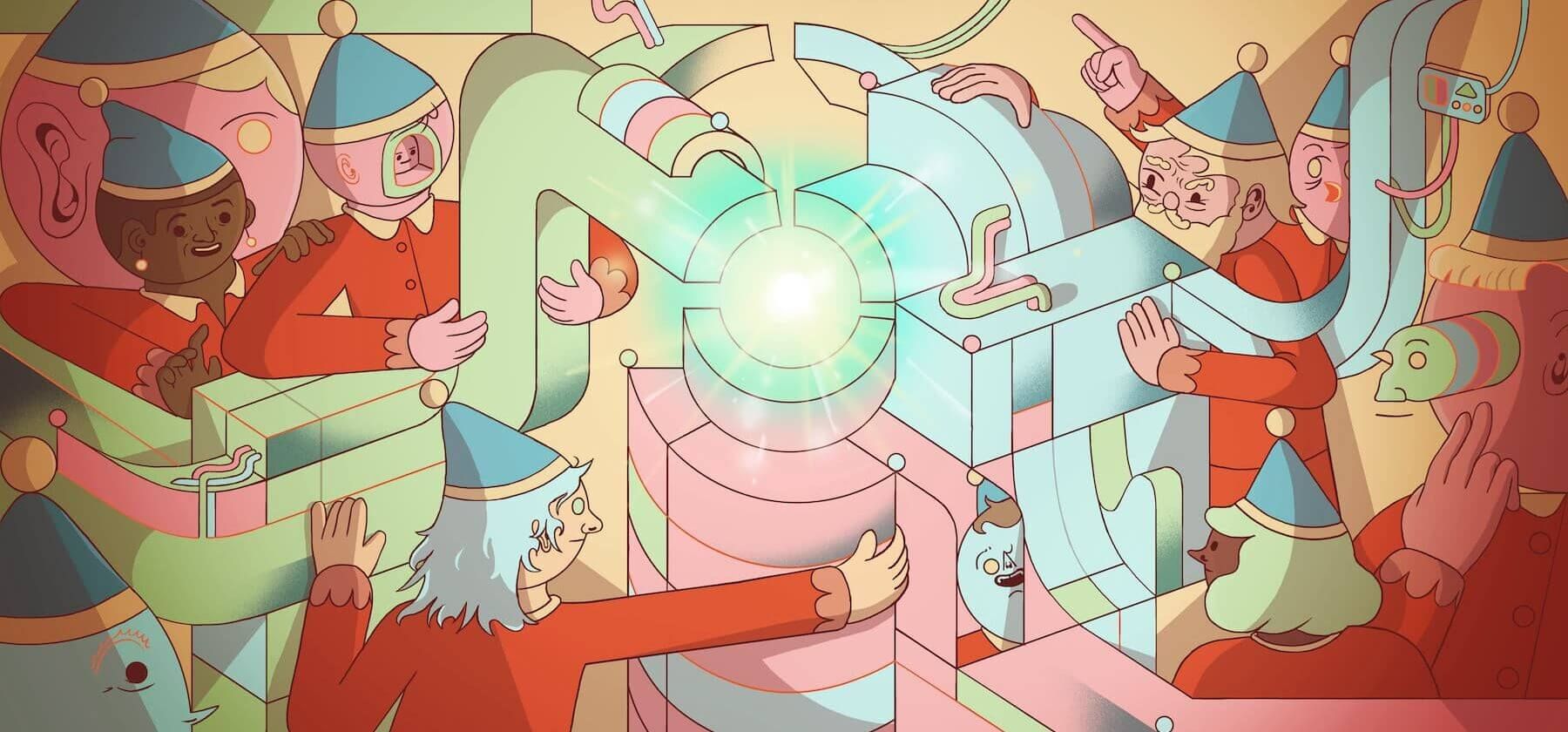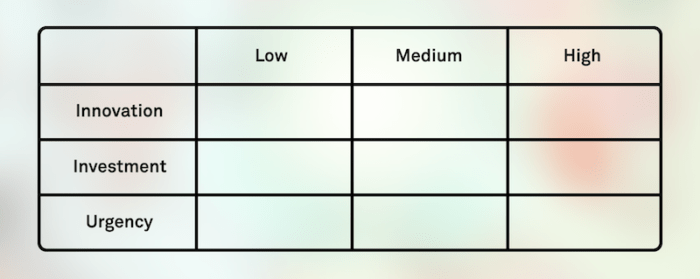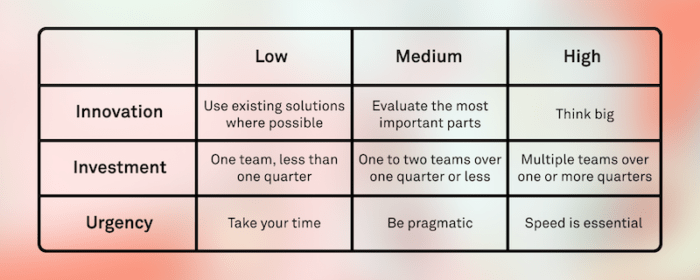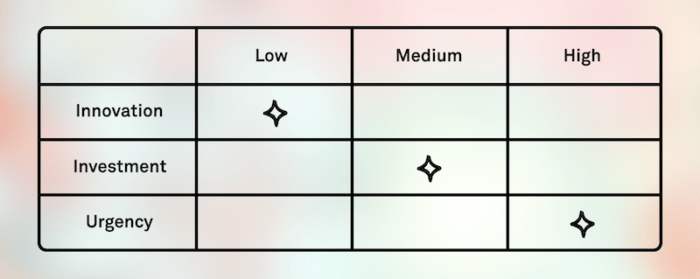
Tackling the problem: A simple three-part framework to align your team’s efforts
Main illustration: Dalbert Vilarino
At Intercom, we start with the problem. But not every problem is created equal, and their solutions shouldn’t be either.
Aligning on three things before diving into a solution can help ensure teams spend the right amount of time and energy solving every problem. We start every project with a problem statement that answers these questions:
- What outcome does the customer want?
- Why do they want it?
- What problems currently exist that prevent them from achieving it?
A well-crafted problem statement ensures the team shares an understanding of the core problem your customers are facing. But not every problem is equally important. Some problems need a straightforward solution, while others require more innovation. Some solutions are resource-heavy undertakings, while others can be achieved more minimally. Some are incredibly urgent – others aren’t.
The steps you take – and the amount of time you spend on each one – should vary from problem to problem depending on these factors. By failing to acknowledge the differences early, teams risk misallocating their focus and energy when solving problems, investing too much or too little in each one.
“It ensures we’re focusing on the right areas with the right resources, and it’s the lever that moves the team from the problem space to the solution space”
To avoid this outcome, we apply a simple three-part framework before we start exploring solutions. By accounting for these differences at the beginning of each project, we can align on how to approach the solution. It ensures we’re focusing on the right areas with the right resources, and it’s the lever that moves the team from the problem space to the solution space.
Our simple team alignment framework
Our team aligns on three points:
- Innovation
- Investment
- Urgency
We rank each point as “low”, “medium”, or “high”.

This communicates the team’s initial thoughts on which steps should be taken and how much effort each step should involve. Here’s a breakdown of each part.
Innovation
Is this solution something we want to innovate on and own as an industry leader and differentiator, or is it table stakes where we want to be on par with the market?
How to rank
Our SVP of Product, Paul Adams, describes innovation as building something new, different, and better. This type of innovation can factor into the business strategy, product strategy, and execution levels. Before we start a project, we usually consider potential innovation within the latter two categories – product strategy and execution.
- At the product strategy level, does this project sit within a product area that requires an innovative solution?
- At the execution level, does this project contribute directly to differentiation or closing product gaps?
Understanding where a project sits within the product strategy should help steer the ranking. If the problem is directly tied to your product’s differentiation, innovation should be higher. The team should spend more time thinking big, evaluating multiple directions, and iterating before committing to a solution.
“If the sole goal of the project is to close product gaps, innovation should be low”
If the sole goal of the project is to close product gaps, innovation should be low. The team should evaluate any existing solutions that can be repurposed quickly instead of spending lots of effort devising new approaches.
There are projects that sit in the middle as well. My team recently took ownership of our Customer Support channel strategy. Building this strategy was a medium-innovation project because we needed to take time to evaluate how Intercom should evolve to become an omnichannel support tool – without reinventing the wheel. We spent two to three weeks outlining our vision for solving the core jobs we had identified, but time-boxed ourselves and avoided evaluating every job listed in the problem statement.
Investment
Do we intend to spend a lot of time on this project and potentially enlist resources beyond our teams? Or is it something we want to solve rapidly at low cost?
How to rank
- Can your team solve this alone? If not, investment will be higher.
- How will you prioritize against other problems?
- Would you spend more time solving this problem than others?
When ranking investment, ensure your team has a practical understanding of what it will take to complete a project. Projects that require a lot of engineering effort, especially if contributions from multiple teams are needed, will automatically rank higher in the investment category.
That said, ranking investment shouldn’t be driven purely by estimating effort. The relative importance of a project should be considered as well. If two projects demand equal effort, but one is critical to achieving a customer outcome, it should be given a higher investment ranking than the other. The team should feel comfortable spending more time on the critical project to ensure they get it right.
Urgency
Is this time-sensitive? Is it something we want to get to the market as quickly as possible, or do we have the luxury of spending a lot of time here?
How to rank
- Is this critical to the company and product strategy? Is solving this problem now strategically important?
- Is it part of a broader launch? If so, how critical is it to that launch?
- Does this problem have a major impact on how customers use and enjoy the product? Does it block a significant portion of customers, or is it something that customers can live with for now?
Urgency can have both top-down and bottom-up inputs. Product and launch strategies can dictate a problem’s urgency from the top down. If your strategy demands a compelling solution in one core area, the urgency to build that solution will be higher.
From the bottom-up perspective, customer impact can be a strong signal of urgency. If a problem has a major impact on how a significant portion of customers use and enjoy the product, solving it should be more urgent. Signals here could include blocked sales deals, NPS and customer feedback, or churn.
“Customer impact can be a strong signal of urgency”
It’s easy to feel like every project on the roadmap should be at least medium or high urgency, but that’s not always true. Urgency should ultimately indicate how quickly we believe we should get a solution into customers’ hands. A project could be strategically important but have an existing solution that satisfies customers. If customers could continue to be happy with the existing solution, the project’s urgency might be low despite its strategic importance.
Consider all three elements together to align on the project’s focus
The confluence of these three elements will dictate what steps your team should prioritize for the project, and roughly how long they should spend on each.

If a problem ranks high on urgency and low on innovation and investment, speed is the priority. We’re not going to spend weeks thinking about how we can differentiate ourselves, this is about quickly achieving a successful customer outcome.
If the task ranks high on innovation and low on urgency, we’re going to take the time to look at the big picture and explore multiple different solutions. Here are examples of a couple of different combinations.
Example 1: Inbox 2
A forthcoming feature we’re working on is the Inbox 2 initiative, which will substantially change the way the Inbox looks and feels for the user. Our inbox is the most frequently used part of our product and is critical to our strategy. Changing it is no small task, but is something we’re keen to do to future-proof it. Here’s how the project looks:
 Project priority: Thinking big
Project priority: Thinking big
Teams contributing: Multiple
Time spent: One to two quarters
Approach: We’ve committed to spend time thinking big, developing a concept car or “North star” design. We’ll also need to source inputs from many teams; research, analytics, sales, customer support, additional product teams, and more.
Example 2: WhatsApp integration
One of the challenges of integrating Intercom’s product with WhatsApp is enabling conversations that start in Intercom’s Messenger to continue in Whatsapp. This requires input from several teams – including security – and solves a critical problem for customers. Here’s how we ranked it:
 Project priority: Speed
Project priority: Speed
Teams contributing: One to two
Time spent: One quarter or less
Approach: Speed is king here, so it’s worth considering obvious paths and utilizing existing patterns. Investment is medium because we need contributions from other teams, but because of the high urgency, we will source only critical inputs.
Align your team and stakeholders early to maximize success
This framework is a useful tool for defining and communicating your team’s approach to a project. Agreeing on these factors early means that everyone – both the immediate team and relevant stakeholders – understands the shape of the solution, and the steps and feedback expected during the project.
If you’re interested in how we work at Intercom, we’d love to talk to you.








